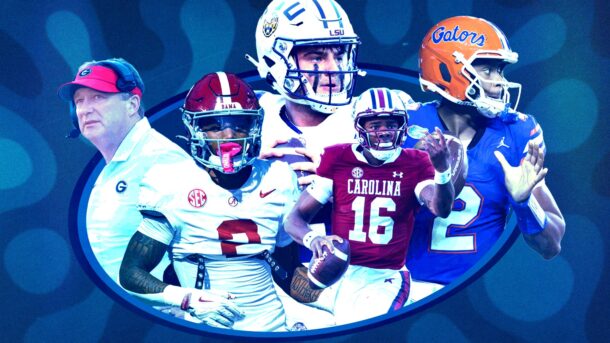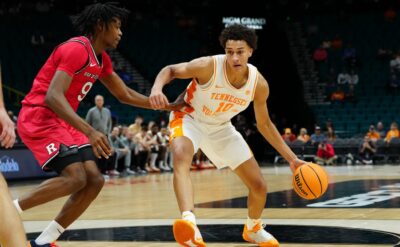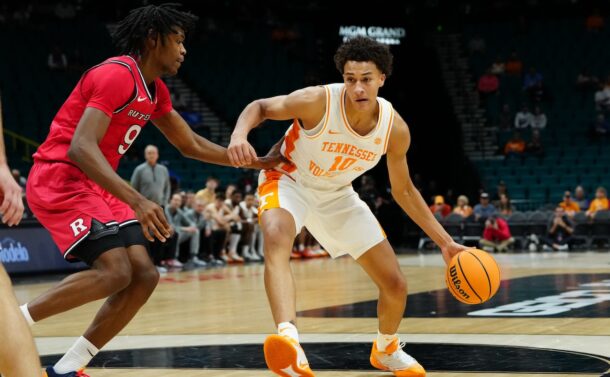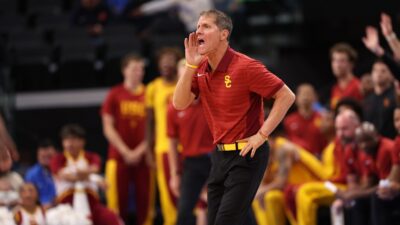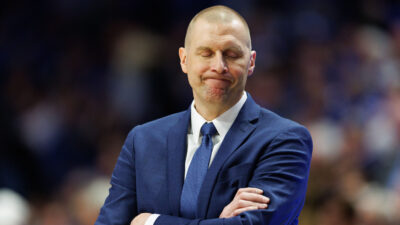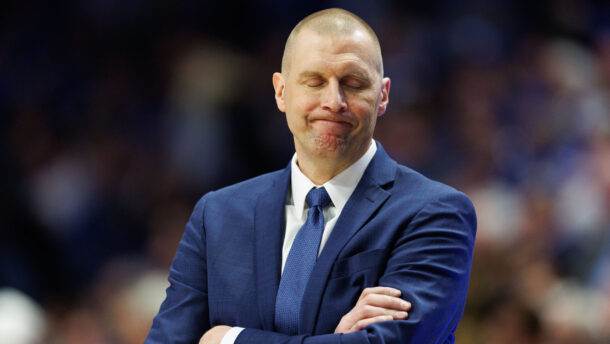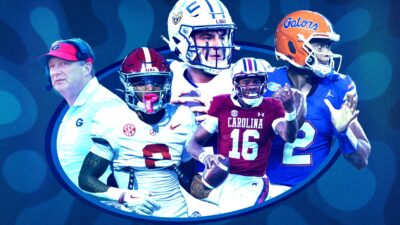
First and 10: Will Dan Mullen be coaching Florida in 2021? It’s far from certain …
By Matt Hayes
Published:
1. I don’t want to get on a soapbox, but …
There’s an uncomfortable pause between Dan Mullen, who led Florida to the SEC Championship Game this season, and the university administration, multiple sources close to the situation told me.
A pause that could make the next 2 weeks a fluid time while the future of the program is figured out.
Mullen, according to an ESPN report Sunday morning, is telling NFL teams he is interested in the league. Meanwhile, Mullen’s bizarre antics this fall haven’t exactly endeared him to the Florida administration.
Then there’s the fallout from Florida’s first NCAA probation in 30 years.
“The public nature of what happened can’t be ignored,” one source told me.
That “public nature” is Florida – the university that holds itself above the fray by winning the right way – was last week placed on 1 year of probation by the NCAA for its head football coach not following NCAA rules.
On purpose.
Multiple sources say that point of contention has been exacerbated this season by multiple public moments where Mullen’s antics have put the university in a bad light.
Then early Sunday morning ESPN reported that Mullen is looking to move to the NFL.
Remember this: Florida athletic director Scott Stricklin has a recent history of quick action when the university’s reputation is at stake.
He made a quick move in 2017 when coach Jim McElwain complained about alleged “death threats” from social media in the middle of a terrible season. When McElwain wouldn’t reveal the source of the threats, Stricklin fired him midseason.
The difference between McElwain and Mullen: One was losing at a disturbing level, the other reached 28 wins quicker than any football coach in school history.
That doesn’t make the NCAA violations – and the intent to do so — any easier to stomach.
Mullen had impermissible contact with a recruit, setting up the planned meeting via a text to tell the recruit when he would be at his high school in Seattle. The NCAA didn’t give the name of the recruit, but it’s not difficult to figure out that it was likely 5-star linebacker Sav’ell Smalls, who eventually signed with Washington.
Members of the Florida coaching staff (which Mullen is accountable for) also had impermissible contact with 7 teams that stopped in Gainesville on their way to a Tampa-area event. The staff gave players tours of the facilities.
For that, and for his “failure to promote an atmosphere of compliance,” Mullen received the harshest penalty a coach can get from the NCAA: a show-cause order, which essentially means any school other than Florida that wants to hire Mullen would have to prove to the NCAA that his hire is justifiable.
While this may seem ticky-tack on the outside, it’s far from that within the Florida administration. Florida was a rogue school in the late 1980s, breaking NCAA rules with the rest of the SEC’s outlaws at the time.
From the moment former athletic director Bill Arnsparger hired Steve Spurrier in 1990, everything changed. Spurrier declared Florida didn’t have to cheat to win the SEC, and then went out and proved it.
Arnsparger, a tough disciplinarian as an NFL and college coach, was hired to clean up the mess at Florida. Jeremy Foley then took over in 1992 and took winning with character to another level. The Gators, along with Stanford, had been the NCAA’s model sports program since, never receiving NCAA probation and becoming an annual fixture at the top of the Director’s Cup all-sports standings.
All that ended with Mullen’s NCAA case. And now it appears Mullen is looking at the NFL.
Mullen said last week that, “college football as we know it will be very different over the next several years. It’ll be, I don’t want to say it’s going to be better or worse, it’s just going to be different than what a lot of college football is used to. The world is ever-changing.”
Mullen spoke to the change in college football – the looming name, image and likeness ruling, more lenient player transfer rules, a more player-friendly system — before Florida’s Cotton Bowl blowout loss to Oklahoma. After the loss, more of what has irked the Florida administration all season showed up again.
Mullen spent his postgame press conference declaring the “last game for the 2020 team was 11 days ago” in the SEC Championship Game.
He talked about how he thought his “scout team players” played well in the game, and that because of COVID protocols, Florida didn’t really have to play in the game, but did, anyway. He gave the impression that his team had little motivation to play.
Those postgame comments became an issue because they minimized an opponent – and more important, brought into question the team’s preparation.
Ole Miss beat No.11 Indiana in the Outback Bowl without 4 of its top offensive threats, and North Carolina took Texas A&M deep into the fourth quarter of the Orange Bowl without more than 4,000 yards of offense from 3 of its top offensive threats.
Mullen’s team was unprepared and got clobbered, and he responded with yet another bizarre press conference.
No university wants to be embarrassed, especially by an employee paid millions to coach football.
Understand this: For the second straight year, Mullen hasn’t yet received a contract extension despite a 29-9 record and 3 straight New Year’s 6 Bowl appearances.
“(The Cotton Bowl press conference) wasn’t the first incident, and (the totality this season) would make anyone pause to take another look and see what we can do better,” another source said.
The next 2 weeks will be fluid and telling.
2. A chain of events
It would be easy to dismiss the Cotton Bowl press conference as a proud coach embarrassed by a loss.
Only that press conference was the latest in a group of questionable acts from a coach who, one source told me, “acts as though he’s bulletproof.”
It began in early October after the first loss of the season at Texas A&M, and with another inappropriate outburst at a public press conference.
Mullen wasn’t happy with the last-second loss and wasn’t thrilled that it appeared Texas A&M had exceeded the SEC mandate on fan limitations. He proclaimed that he wanted to “pack the Swamp” the following week for the LSU game – during a pandemic. The optics for that were brutal.
Days later, he tested positive for COVID, and the team had a significant outbreak of more than 30 players and staff. Three weeks later, in the first game since the outbreak led to a pause of activities, he raced onto the field at halftime and appeared to instigate a near brawl between Florida and Missouri.
He claimed after the game that he was trying to separate the teams, but video evidence appeared to show him as an instigator. Mullen showed up to the postgame press conference (on Halloween night) dressed as Darth Vader – and gave convoluted answers about the fight in costume.
Then the Cotton Bowl press conference happened, and a clear pattern had emerged. In 3 different press conferences during the season, where Mullen was placed at the forefront as the face of the team and university, his behavior was questionable at best and embarrassing on many levels.
The press conference behavior was easier to ignore when Florida was winning games and in the middle of the national championship race. When the Gators were wrapping up a 3-game losing streak with a 35-point loss to Oklahoma, the behavior was seen through a more critical lens.
It’s nearly identical to the process of how the university overlooked clear personality conflicts with McElwain (who won back-to-back SEC East Division titles) until it no longer could. McElwain gave Florida the ability to fire him and mitigate a large buyout by refusing to give information about alleged death threats.
Mullen put the Florida administration in a tenuous situation of dealing with a difficult season while watching its coach look for an NFL job.
3. The next step
The obvious question: Where does Florida go if the Mullen marriage is over?
More than anything, the university wants a coach it can trust, and one that won’t put it in embarrassing situations.
Iowa State coach Matt Campbell, whose team won the Fiesta Bowl Saturday against Oregon, would be at the top of any list of replacements.
Campbell, 41, is a rising star in the profession, and has turned around a moribund Iowa State program and reached 4 straight bowl games, including a win in the program’s first major bowl. He is 34-28 in 5 seasons and had the Cyclones in the Big 12 Championship Game this season.
There are other potential candidates — Penn State coach James Franklin, Minnesota coach P.J. Fleck, Louisiana coach Billy Napier – but there is hope in Gainesville that a post-bowl examination of all things football can move toward a greater working environment.
That is, if Mullen doesn’t leave for the NFL.
4. The new, harder job
Mullen isn’t the only SEC coach concerned about the NCAA moving toward a more player-friendly system.
It’s not that coaches don’t want to help players succeed and earn, it’s that new rules will make it that much tougher to build a consistent winner.
And it’s pushing more coaches to look at the NFL, where it’s all football, all the time.
“(The NCAA) is throwing up roadblocks everywhere you look – and they don’t realize the unintended consequences of it,” an SEC coach told me. “We’re asking these guys to be accountable for one another. That’s life goals, relationship goals, work goals. Not just football. These new rules are all geared toward “I” not “we.” That’s a big problem.”
The biggest offender, coaches say: transferring without having to sit out a season. The NCAA is working on a proposal that will allow players to transfer one time without sitting out a season. It should be passed in time for the 2021 season.
That, coaches say, will contribute to roster breakdown and instability, and more cheating in recruiting. There will be a mad rush to fill holes from players leaving – players teams invest in for multiple seasons, and get little or nothing in return.
The new name, image and likeness rule that becomes law in the state of Florida in July 2021 (no matter what the NCAA does with its pending NIL bill), could also cause problems.
“It’s a good thing that players get to monetize their value, but you’re creating a chasm between those that can and those that can’t yet,” another SEC coach told me. “Then they go to practice and hear us tell them what you do on and off the field directly impacts the guy next to you. They’re thinking, ‘yeah it does, but he’s getting paid and I’m not.’”
One more thing: The money is better for coaches in the NFL. When Matt Rhule coached at Baylor, he was among the top 30 paid coaches in college football.
When he signed to coach the Carolina Panthers, he became the 6th-highest-paid coach in the NFL with a 7-year, $60 million contract ($8.5 million per).
5. The Weekly Five
The top 5 SEC assistant coaches primed to become head coaches:
1. Brian Johnson, offensive coordinator, Florida
2. Jeff Lebby, offensive coordinator, Ole Miss.
3. Todd Monken, offensive coordinator, Georgia
4. Mike Elko, defensive coordinator, Texas A&M
5. Pete Golding, defensive coordinator, Alabama
6. Your tape is your résumé
An NFL scout breaks down a draft-eligible SEC player. This week: Auburn WR Seth Williams.
“A ton of raw talent. I look at him like I used to look at all of those LSU receivers who had to play with quarterbacks who couldn’t get them the ball. Is he a Jarvis Landry or Odell Beckham type player? Maybe not at that level, but he shows elite talent at times. He’s certainly a DJ Chark type player.
“He’s so fluid, and makes tough catches and highpoints the ball so well. He just doesn’t do it on a consistent basis. Now, is that because of what he has at quarterback? That’s the question you have to answer.
“He’s going to test well, and he’ll be one of the many guys that when Day 2 rolls around and a team is on the clock, they’ll be asking for any bit of information that maybe was missed that might swing a choice one way or the other.”
7. Powered Up
The final Power Poll – and the biggest spring practice question.
1. Alabama: Who does Nick Saban hire as offensive coordinator, and how quickly can he mesh with QB Bryce Young?
2. Texas A&M: Can the Aggies replace 4 seniors on the offensive line – a group that paved the way for a breakout season.
3. Florida: Who wins the quarterback job? What was an easy guess earlier this year (Emory Jones), may not be so simple with the potential of Anthony Richardson.
4. Georgia: Can JT Daniels develop into the elite prospect he was as a prep phenom?
5. LSU: Will new coordinators on offense and defense give the Tigers a jolt back into the SEC elite?
6. Ole Miss: Can freshmen, junior college and transfer portal players change the fortunes of the defense?
7. Missouri: Can QB Connor Bazelak develop into an elite player in Year 2 as a starter?
8. Auburn: Can Bryan Harsin make Bo Nix a more complete quarterback?
9. Kentucky: How quickly will the UK offense embrace the philosophy of new coordinator Liam Coen?
10. Arkansas: Will the Hogs open up the offense in Year 2 under coordinator Kendal Briles?
11. Tennessee: Can coach Jeremy Pruitt keep a fragile team together over the long offseason?
12. Mississippi State: Can Will Rogers, whom Mike Leach calls his best quarterback at this stage of his career, throw downfield more efficiently?
13. South Carolina: Can Shane Beamer fix a culture of expecting to lose?
14. Vanderbilt: Can Clark Lea convince the Vanderbilt administration to commit more to football without coaching a down of football?
8. Ask and you shall receive
Matt: OK, man, tell me we’re going to roll Ohio State next week. I don’t know why. I feel really nervous about this one.
Thomas Littleton
Birmingham, Ala.
Thomas: You should feel nervous. What Ohio State did to Clemson could very easily become what Ohio State does to Alabama. There’s a reason Ohio State coach Ryan Day was so adamant about playing this season, saying over and over that he believed he had a team that could win it all.
But there is a weakness on that team, one that Alabama can exploit – and one that Clemson couldn’t. Because Ohio State could get pressure with four up front (and sometimes three) against Clemson’s overmatched line, the Buckeyes were able to hide their issues in pass coverage.
Alabama’s offensive line has been dominant all season, and teams have had to bring more than four to pressure QB Mac Jones. At that point, someone is left in man coverage in the back end – and that’s where Jones will make Ohio State pay.
If there’s one distinct advantage, it’s that Ohio State will do everything it can to stop Alabama TB Najee Harris. When the Buckeyes commit more players to stop the run, Jones will make key intermediate and deep throws.
As long as all things are equal (see: turnovers), Alabama should win another national title the same way it beat Florida: scoring more points than the other guy.
9. Numbers: 4.84
Najee Harris has been Alabama’s most valuable player in the postseason. He sets the tone in the run game and forces defenses to commit to stopping the run. He also gets the tough yards. In 25 3rd-down carries this season, he’s averaging 4.84 yards per carry, with 121 yards and 5 TDs.
10. Quote to note
Georgia coach Kirby Smart on the Bulldogs’ game-winning field goal to beat Cincinnati: “It was going to be the highs of high, the lows of low. The truth lies somewhere in the middle.”
Matt Hayes is a national college football writer for Saturday Down South. You can hear him daily from 12-3 p.m. on 1010XL in Jacksonville. Follow on Twitter @MattHayesCFB
